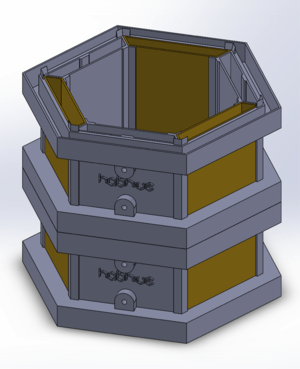Project SPACE
Project SPACE (Space Payload) or SPCE is the Balloons team project to create a modular payload for high altitude balloon launches. The goal is to create a payload with interchangeable panels and floors so that groups that want to put experiments at near space on one of the balloons can easily modify individual small parts and be ready to launch very quickly.
The current team leads are Brandon Vabre and Yuji Sugimoto.
Origins
Kirill Safin had the initial idea to create a modular payload for balloons launches.
2015-2016
The project was revamped in late 2015 along with its sister projects UV, Sol, Loon, and hab MC.
HAB HIVE (High Altitude Balloon, Hexagonal Integrated Vehicle for Experimentation) Iteration 1: In the initial design session it was decided to make a cube-sat like approach to the payload by having individual “cans” that would act like 1 U of a satellite. These cans would feature double walls that could sandwich aerogel in between in a thermos type idea in order to insulate the payload. Three of the walls would be able to be “Hot swap” panels (panels that can be taken out and interchanged) that can be modified for different experiments. The cans would be kept together by using bands that fit over the outside of the cans with an aerogel insert (similar to the cans themselves) that could be bolted in. These bands have a secondary use by insulating the area between the two cans that have no aerogel. It was also decided to use the new SSI 3D printer in order to make these due to having it readily accessible therefore giving us the ability to make rapid iterations. The shape of the cans was chosen to be hexagonal to maximize the circular build plate area of the 3D printer while still maintaining flat sides.
SSI-28
The first iteration of HAB HIVE was set to launch on SSI-28 as the payload that would house Project X and Project UV. Unfortunately due to 3D printer failure at multiple points during the last week of construction, the team was not able to deliver a product for the launch. We were still able to crash test our payloads by attaching what we had onto the bottom of SSI 28. The payload did survive landing.
